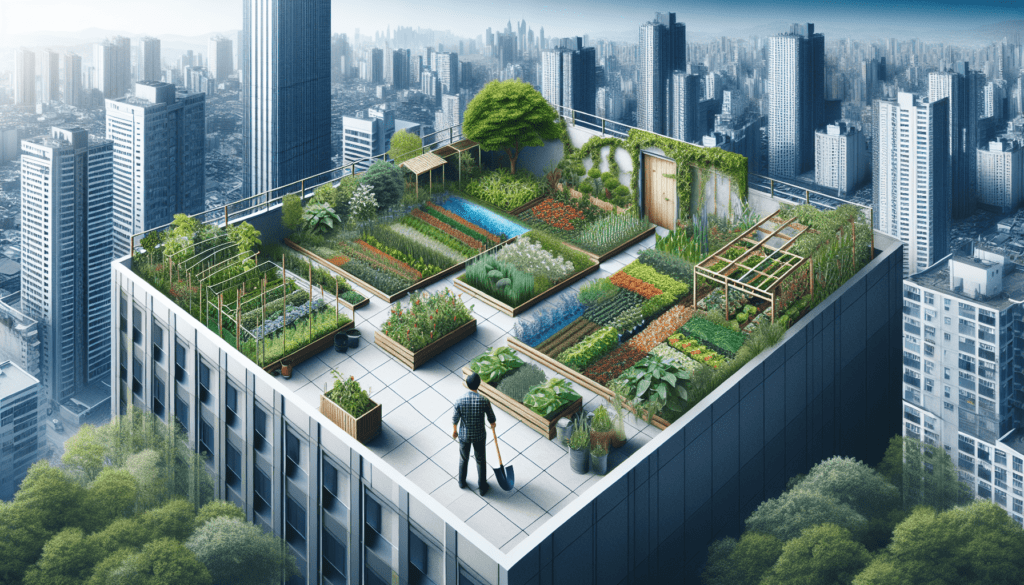Imagine transforming an otherwise unused rooftop into a lush haven of greenery and life. From bustling urban cities to cozy suburban homes, rooftop gardening has gained immense popularity in recent years. This article explores the challenges and triumphs that come with this unique form of gardening, showcasing how individuals have overcome limitations to create thriving rooftop gardens. Discover the secrets to success and be inspired to turn your own rooftop into a beautiful oasis.
Benefits of Rooftop Gardening
Environmental Benefits
Rooftop gardening offers numerous environmental benefits. By covering rooftops with vegetation, you can help combat climate change as plants absorb carbon dioxide and release oxygen. Additionally, rooftop gardens act as natural insulators, reducing the energy needed for heating and cooling buildings. They also help reduce air pollution by filtering out harmful pollutants and improving overall air quality. With the loss of green spaces in urban areas, rooftop gardening provides a much-needed habitat for birds, insects, and other wildlife.
Health Benefits
Rooftop gardening also provides numerous health benefits. Spending time surrounded by plants and nature has been proven to reduce stress levels and promote mental well-being. Rooftop gardens offer a peaceful retreat from the hustle and bustle of city life, providing a therapeutic space for relaxation and rejuvenation. Additionally, growing your own fruits, vegetables, and herbs in a rooftop garden allows you to have access to fresh and organic produce, promoting a healthy diet and lifestyle.
Aesthetic Benefits
One of the most obvious benefits of rooftop gardening is the enhancement of the visual appeal of a building. Rooftop gardens add a touch of greenery to the concrete jungle of urban areas, creating a beautiful and inviting environment. They can transform once-empty rooftops into vibrant and colorful spaces, adding a natural element to the surrounding skyline. The aesthetic benefits of rooftop gardening also extend to the interior of buildings, as rooftop gardens can be visible from upper floors, providing a pleasant view for occupants.
Challenges Faced in Rooftop Gardening
Limited Space
The limited space available on rooftops poses a significant challenge for rooftop gardening. Unlike traditional gardens, rooftop gardens have unique space constraints that require careful planning and utilization. However, with strategic design choices and proper plant selection, even small rooftop spaces can be transformed into thriving gardens.
Weight Considerations
Weight considerations are crucial when it comes to rooftop gardening. The additional weight of plants, containers, soil, and water can put excessive strain on the structural integrity of a building. It is essential to consult a structural engineer to ensure that the rooftop can safely support the added weight. Lightweight alternatives such as using lightweight containers and soil mixes can help alleviate this challenge.
Access to Water and Sunlight
Rooftops typically lack the natural resources that traditional gardens have easy access to, such as water and sunlight. It is essential to assess the availability of water sources and sunlight exposure on the rooftop before starting a garden. Implementing irrigation systems can help provide a consistent water supply, while choosing plants that thrive in full sun or partial shade can optimize the use of available sunlight.
Drainage Issues
Rooftops are prone to drainage problems due to their sloping surfaces and limited natural drainage options. Proper drainage solutions, such as installing drainage trays, can help prevent water accumulation and avoid damage to the rooftop structure. Including a layer of gravel or using porous containers can also improve drainage and prevent waterlogged soil.
Extreme Temperature and Wind
Rooftops are often subjected to extreme temperatures and high winds, which can impact the health and growth of plants. The elevated position of rooftops exposes plants to more intense sunlight and heat, requiring careful plant selection and sun exposure planning. Windbreaks and shading structures can help protect plants from strong gusts and excessive sun exposure, ensuring their overall health and productivity.
Maintenance and Upkeep
Maintaining a rooftop garden requires a commitment to regular upkeep. Rooftop gardens often require more frequent watering, fertilization, and pest control due to their exposure to weather elements and limited soil volume. A regular maintenance routine, including watering schedules, pruning, and soil replenishment, is essential for the long-term success of a rooftop garden.

Strategies to Overcome Challenges
Choose Suitable Plants
To overcome the challenges of limited space, weight considerations, and environmental conditions, selecting suitable plants is crucial. Opt for plants that are well-suited to rooftop gardening, such as drought-tolerant and compact varieties. Consider vertical gardening techniques to maximize space utilization.
Optimize Space with Vertical Gardening
Vertical gardening techniques, such as installing trellises, hanging baskets, or living walls, can effectively utilize vertical space and provide additional growing areas. Vertical gardens not only maximize space but also create a visually appealing feature on the rooftop.
Use Lightweight Containers and Soil
To address weight considerations, opt for lightweight containers made from materials such as plastic or fiberglass. Additionally, using lightweight soil mixes, such as soilless potting mixes or perlite-based mixes, can reduce the overall weight of the garden while still providing adequate nutrients for plant growth.
Install Irrigation Systems
To ensure a consistent water supply for rooftop gardens, consider installing irrigation systems. Drip irrigation systems, in particular, are efficient and can deliver water directly to the plant’s roots, minimizing water waste and evaporation.
Implement Proper Drainage Solutions
To mitigate drainage issues, incorporate proper drainage solutions into the design of the rooftop garden. Installing drainage trays or using raised beds with adequate drainage can help prevent water accumulation and potential damage to the rooftop structure.
Provide Shade and Windbreaks
To protect plants from extreme temperatures and high winds, provide shade and windbreaks on the rooftop. Shade structures, such as pergolas or shade sails, can help filter out excessive sunlight. Windbreaks, such as trellises or solid panels, can provide a barrier against strong winds.
Establish a Regular Maintenance Routine
To ensure the long-term success of a rooftop garden, establish a regular maintenance routine. Set watering schedules, monitor plant health, fertilize as needed, and address pest issues promptly. Regular pruning and soil replenishment will also help maintain healthy and thriving plants.
Common Rooftop Gardening Techniques
Container Gardening
Container gardening is a popular technique for rooftop gardens. Plants are grown in containers such as pots, boxes, or hanging baskets, making it easier to control soil conditions and maximize space utilization. Container gardening allows flexibility in plant selection and provides portability, making it suitable for rooftop environments.
Raised Bed Gardening
Raised bed gardening involves growing plants in raised beds or boxes filled with soil, providing better drainage and aeration compared to traditional in-ground gardens. Raised beds can be custom-built to fit the available rooftop space, and they offer excellent control over soil quality and depth.
Hydroponics
Hydroponics is a soilless gardening technique that involves growing plants in nutrient-rich water solutions. This technique maximizes water efficiency and allows for year-round gardening. Hydroponics systems can be customized to fit rooftop spaces, making them a viable option for urban gardening.
Green Roof Systems
Green roof systems, also known as living roofs, involve covering the entire rooftop surface with a layer of vegetation. These systems provide a myriad of environmental benefits, including improved energy efficiency, reduced stormwater runoff, enhanced air quality, and extended roof lifespan. Green roofs require specialized design and installation, but they can transform a rooftop into a thriving ecosystem.

Best Plants for Rooftop Gardening
Herbs and Vegetables
Herbs and vegetables are popular choices for rooftop gardening. Herbs like basil, thyme, and rosemary thrive well in containers and can be easily harvested for culinary uses. Leafy greens such as lettuce, kale, and spinach can also be successfully grown in rooftop gardens, providing a fresh and nutritious food source.
Succulents and Cacti
Succulents and cacti are excellent choices for rooftop gardens, particularly in arid or drought-prone regions. These resilient plants require minimal watering and can withstand extreme temperature fluctuations. Succulents and cacti also add a unique and visually striking element to rooftop gardens.
Flowering Plants
Flowering plants add color and vibrancy to rooftop gardens. Choose varieties such as marigolds, petunias, and geraniums, which are well-suited to container gardening. Flowers not only enhance the aesthetic appeal of the garden but also attract pollinators, contributing to the biodiversity of the urban environment.
Grasses and Groundcovers
Grasses and groundcovers are excellent choices for rooftop gardens, particularly in areas with limited space. Ornamental grasses such as feather reed grass and blue fescue add texture and movement to the garden, while low-growing groundcovers like creeping thyme or sedum create a lush carpet effect.
Designing a Rooftop Garden
Assessing the Rooftop Structure and Load-Bearing Capacity
Before embarking on designing a rooftop garden, it is essential to assess the rooftop structure and load-bearing capacity. Consult a structural engineer to ensure that the rooftop can safely support the additional weight of the garden. This assessment will determine the size and scope of the garden.
Creating a Layout and Theme
Creating a layout and theme for your rooftop garden will help guide the design process. Consider the available space, sunlight exposure, and desired aesthetic appeal. Choose a theme that suits your preferences, whether it’s a formal garden, a tropical paradise, or a serene Zen retreat. A well-thought-out layout will optimize space utilization and create a cohesive and visually appealing garden.
Plan for Sun Exposure and Shade
Understanding the sun exposure on your rooftop is crucial for successful plant growth. Take note of which areas receive full sun, partial shade, or full shade throughout the day. This information will inform plant selection and placement, ensuring that each plant receives the appropriate amount of light. Incorporate shade structures in areas exposed to excessive sunlight to protect sensitive plants.
Consider Aesthetics and Feng Shui
Considering aesthetics and feng shui principles can elevate the design of your rooftop garden. Choose plants and decorative elements that create a harmonious and balanced environment. Incorporate elements such as water features, sculptures, or seating areas to enhance the overall ambiance and create a welcoming space for relaxation.
Incorporate Functional Elements
Rooftop gardens can serve multiple functions beyond aesthetics. Consider incorporating functional elements such as edible plants, seating areas, or even a small greenhouse or conservatory. These elements not only enhance the usability of the garden but also contribute to its overall appeal.
Benefits of Green Roofs
Improved Energy Efficiency
Green roofs act as natural insulators, reducing the energy required for heating and cooling buildings. The layer of vegetation provides additional insulation, reducing heat transfer between the building and the external environment. This improved energy efficiency can lead to lower energy bills and a reduced carbon footprint.
Reduced Stormwater Runoff
Green roofs help reduce stormwater runoff by absorbing rainwater, preventing it from overwhelming drainage systems and causing urban flooding. The vegetation and soil on green roofs act as natural sponges, enabling the gradual release of water back into the environment. This reduction in stormwater runoff helps alleviate pressure on local water management systems.
Enhanced Air Quality
Green roofs improve air quality by removing pollutants and particulate matter from the atmosphere. Plants absorb carbon dioxide and release oxygen through photosynthesis, helping to reduce greenhouse gas emissions. The vegetation and soil on green roofs also trap and filter airborne pollutants, resulting in cleaner and healthier air in urban areas.
Temperature Regulation
Green roofs contribute to temperature regulation in urban areas by reducing the urban heat island effect. The vegetation on green roofs absorbs and reflects heat, preventing excessive heat buildup in urban environments. This cooling effect helps reduce energy consumption for air conditioning and creates more comfortable outdoor spaces.
Extended Roof Lifespan
Green roofs act as a protective layer for the underlying roof structure, extending its lifespan significantly. The layer of soil and vegetation acts as a natural barrier against UV radiation and temperature fluctuations, reducing the wear and tear on the roof membrane. Green roofs can double or triple the lifespan of a conventional roof, providing long-term cost savings and environmental benefits.
Permits and Regulations for Rooftop Gardening
Check Local Building Codes
Before starting a rooftop garden, it is essential to check local building codes and regulations. Some jurisdictions may have specific requirements or restrictions regarding rooftop gardens, particularly in terms of structural requirements, fire safety, and weight limitations. Understanding and following these codes will ensure compliance and safety.
Obtain Necessary Permits
Depending on the location and size of the rooftop garden, permits may be required. Some municipalities may require permits for rooftop structures, water connections, or modifications to the building’s exterior. It is essential to inquire with the relevant authorities to determine the necessary permits and ensure compliance throughout the process.
Comply with Fire and Safety Standards
Rooftop gardens should comply with fire and safety standards to minimize the risk of fire hazards or emergency situations. This may include installing fire-resistant materials, maintaining clear access routes for emergency vehicles, and following fire safety guidelines for vegetation. Consult local fire and safety authorities to ensure compliance.
Consider Legal and Liability Aspects
When starting a rooftop garden, it is crucial to consider legal and liability aspects. Ensure that you have the necessary insurance coverage to protect against any potential damages, injuries, or claims arising from the garden. Contact a professional insurance provider to discuss coverage options specific to rooftop gardens.
Success Stories and Inspiration
Rooftop Gardens in Urban Centers
Many urban centers around the world have embraced rooftop gardening as a sustainable solution for green spaces in dense cities. Cities like New York, Chicago, and Singapore have seen the rise of numerous successful rooftop gardens, transforming once-empty rooftops into lush and vibrant oases. These rooftop gardens contribute to local food production, enhance the urban environment, and inspire other cities to follow suit.
Community and Collective Rooftop Gardens
Community and collective rooftop gardens have gained popularity as a way to bring people together and promote sustainable living. These gardens often operate as shared spaces, allowing community members to grow their own produce and foster a sense of camaraderie. Community rooftop gardens also educate and inspire others to take up rooftop gardening, promoting environmental awareness and social cohesion.
Celebrity Rooftop Gardens
Celebrities have embraced rooftop gardening as a way to connect with nature and create peaceful retreats within their urban homes. These rooftop gardens often feature luxurious designs, breathtaking views, and a wide array of plants and amenities. Celebrity rooftop gardens serve as inspirations for design enthusiasts and prove that rooftop gardening can be both practical and aesthetically pleasing.
Conclusion
Rooftop gardening is a growing trend that offers numerous benefits, from environmental and health advantages to aesthetic enhancements. While it presents its fair share of challenges, such as limited space and weight considerations, these obstacles can be overcome with strategic planning and innovative solutions. By choosing suitable plants, optimizing space, and implementing the appropriate gardening techniques, rooftop gardens can flourish in urban environments. Additionally, incorporating green roof systems and adhering to permits and regulations can further enhance the sustainability and safety of rooftop gardens. With success stories and inspiration from around the world, rooftop gardening is proving to be an effective way to harness the benefits of green spaces and create thriving ecosystems in urban areas. So, whether you’re an aspiring gardener or a seasoned green thumb, consider taking your gardening skills to new heights and embark on the exciting journey of rooftop gardening.

